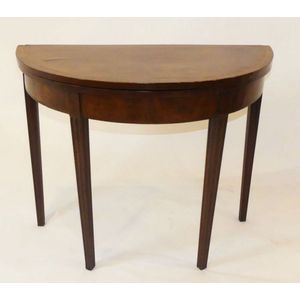Georgian Double Gateleg Games Table with Baize Top
You must be a subscriber, and be logged in to view price and dealer details.
Subscribe Now to view actual auction price for this item
When you subscribe, you have the option of setting the currency in which to display prices to $Au, $US, $NZ or Stg.
- Georgian - As an English stylistic period, Georgian is usually taken to cover the period from George I (1714) to the Regency of Prince George (1811-20), although the period from 1800 to 1830 is sometimes designated as the Regency period. During the Georgian period the great English cabinetmakers and designers such as Chippendale, Hepplewhite, Adam Sheraton etc., were all active.
Therefore there isn't a single 'Georgian style' as such and to say something is 'Georgian', usually means it was made between 1714 and 1830. This assumes we discount George V and George VI, both being from the 20th century.
The styles popular at the time of each reign were:
George I (1714-1727) saw out the last years of the Baroque period.
George II (1727-1760) reigned during the Rococo period.
George III (1760-1820) saw the last gasp of the Rococo, all of the early Neo-Classic 'Adam style' and most of the later neo-Classic 'Regency style'.
George IV (Prince Regent 1820-1830)encompassed the last of the 'Regency' style.
William IV's reign (1830-1837) was something of a no man's land (stylistically) and he wasn't a 'George' anyway. He covered the last glimmerings of 'Regency' and the start of the 'Victorian' style. - Demi Lune - Demi-lune is a French word translating to half-moon or crescent-shaped. In jewellery the demi lune shape is used in the design of pendants and earrings. The crescent shape adds a touch of elegance and femininity, and is often used to symbolize the moon or to evoke a sense of mystery and magic. In furniture design, a demi-lune table is a narrow, crescent-shaped table that is often used as an accent piece or in small spaces where a full-sized table would not fit. Demi-lune tables were popular in the 18th and 19th centuries and were often decorated with intricate carvings or inlaid designs.
This item has been included into following indexes:
Visually similar items

Fine antique Georgian mahogany demi lune card table, standing on square tapering legs

A Sheraton mahogany demi-lune side table with satinwood and ebony inlay, English, early 19th century, on brass castors, 76 cm high, 121 cm wide, 60 cm deep

Edwardian Sheraton Revival card table. Demi lune, green baize top, spade feet. Split to top. Height 74 cm. Depth 104 cm

Near pair of demi-lune side tables with painted decorative edges, one in white and one in grey. Height 73.4 cm. Width 122 cm. Depth 53 cm. Provenance: Collection of Margot Montgomery
